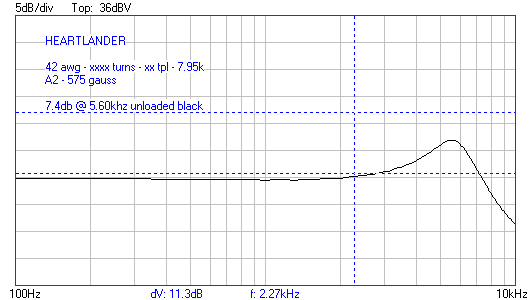Frequency response. Why is it important?
Here we can see the resonant peak of the humbucker.
Unless you are interested in calculating the length of a coil or comparing it with another similar coil, forget about DC resistance. If you know a pickups resonant frequency and resonant peak height, you know roughly 90% of its transmission characteristics; those two parameters are key to the mystery of the sound of the pickup.
When wired in series, the pickups total inductance is increased, lowering its resonance frequency and reducing the highest frequencies, giving it a less harsh tone than would either component of a two-coil pickup by itself. This also increases the resistance/impedance of the pickup, which may impact higher frequencies unless the pickup is isolated with a buffer amp or a DI unit. Adding an internal buffer amplifier can isolate the pickup from some of the load effects from cable capacitance, thereby giving you brighter sounds with higher resonance frequencies and higher peaking
The resonant frequency depends on the inductance L , usually between 1 and 10 Henries and on the capacitance C. The capacitance C is the sum of the coil winding capacitance, usually between 80 and 200pf and the capacitance of the cable which is around 300 to 1000pf. The resonance frequency for most available pickups, when combined with regular guitar cables, is in the range of 2 kHz to 5 kHz. The typical highest single-coil pickup is about 5 kHz, and the highest notes on the fretboard on a typical guitar are at 1.17 kHz.
The picture above demonstrate the frequency response of a pickup connected under load. If you give the pickup a steady, non-variable control signal instead of a string vibration and graph the output at all relevant audio frequencies, you will end up with an Bode plot, which is simply a graph of amplified volume against frequency.
Depending on the guitar, one, two, or more pickups may be present, with different types and configurations. Physical parameters for guitar pickups include location, width, and combinations of several pickups of different levels and polarities. Active pickups reduce noise by filtering out electromagnetic interference, and they influence frequency response (EQ) and audio impedance.
Reproduction means each magnetic pickup will transduce, or convert the sound from certain frequencies more effectively than others. Pickups will convert more efficiently as frequencies rise up to their resonance peaks, which are always higher than the highest basic notes on a guitar.
The implication is that pickups respond to certain frequencies in different ways because of their design. There is another way of measuring pickups but this requires a complicated measurement of impedance across all the frequencies that they are picking up.
I hope this was informative and that you will have a better idea of why the resonant frequency and the resonant peak are one of the most important factor in understanding the sound of a pickup. Winding and voicing a pickup is considered an art and to a certain degree I definitely agree with that. But remember this! Pickups are electromagnetic devices and as such they obey one of the 4 fundamental laws of physics. ELECTROMAGNETISM. No matter how artistic one can be, ignoring it will have a profound impact on the quality of the tone of any pickup.

